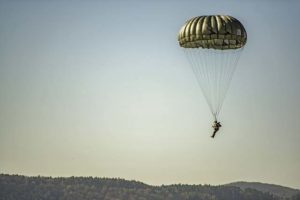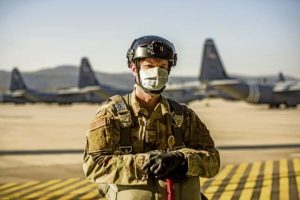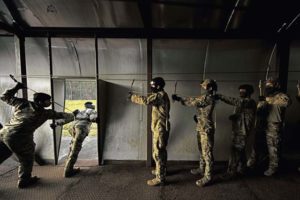
The 435th Contingency Response Group conducted airborne operations to maintain proficiency and qualifications at Ramstein Air Base, April 7-8.
The 435th CRG is the only contingency response force in the Air Force that maintains an airborne insertion capability. Adding such a vital capability to the U.S. Forces in Europe-Air Forces Africa retinue requires CRG Airmen to maintain currency in training as well as remain ready, resilient Airmen who can execute the mission – anytime, anyplace.
The medical team assigned to the 435th Contingency Response Support Squadron met with the paratroopers in the morning to ensure they were in good health in order to perform their airborne jumps. Independent Duty Medical Technicians provided a coronavirus disease 2019 preflight screening and briefed risk mitigation techniques prior to boarding the aircraft.
“Our IDMTs are the front line of medical care for a majority of our missions and exercises,” said Capt. Talon Miner, 435th CRSS director of medical operations. “Our people are the reason we are able to do the things we do and why we are able to do them so well.”
Proactive measures limited exposure and spread of COVID-19 while still allowing them to train.
“We are taking extra precautions to mitigate the risk of COVID-19 transmission during this global pandemic,” Miner said. “We work closely with several units including the 86th Medical Group and 37th Airlift Squadron to ensure we are all following the latest guidance to keep our members protected and healthy.”

While COVID-19 is a threat, it must be treated just like any other threat: training will limit the degradation of Air Force’s readiness, responsiveness and lethality. The 435th CRG continues to take every step to ensure the wellness of their Airmen while also safeguarding their national mission capabilities.
“There aren’t a lot of units that are jumping in the Air Force right now,” said Maj. Doug Dinkins, 435th Security Forces Squadron commander. “We want to continue to execute these operations. That’s why we are going through extra precautions to ensure our members safety and health stay as a top priority.”
Each Airman wore protective cloth masks, disposal rubber gloves and had a heightened awareness of the physical distancing regulations during training. The 435th CRG Airmen are on a 72-hour response time to answer any call which emphasizes the importance of their health.
“We ensure our nation, partners, allies and those who would choose to be our adversary understand that it is impossible to deny the employment of airpower anywhere in this area of operation,” said Col. Jason Terry, 435th CRG commander.
Airborne operations provide combatant commanders added flexibility when they request assistance to open an airbase in uncertain austere environments.
“The team of airborne qualified Airmen can drop into an airfield and then rapidly assess it for aircraft suitability,” said Master Sgt. Jim Burke, 435th Contingency Response Squadron operations superintendent. “Operations like these demonstrate the continued readiness of the 435th CRG and remind all parties that we still have the ability to insert paratroopers into any place at any time – even during a global pandemic.”

Military freefall requires a skill set which can diminish if it’s not continually practiced, Burke added.
The jumps allow paratroopers to assess and hone their skillsets while under canopy and control parachute landing fall procedures. A lot of coordination goes into planning airborne training opportunities. The 37th AS and 86th Operational Support Squadron compliment this training by partnering with the CRG to provide airlift for proficiency jumps over Ramstein Air Base.
“Leveraging partnerships is of critical importance to the 435th CRG,” said Maj. Brad Seehawer, 435th CRS operations officer. “These jumps are a direct reflection of the outstanding support we’ve received from the 37th Airlift Squadron, 86th Operations Support Squadron, 721st Air Mobility Operations Group, and 5th Quartermaster Theater Aerial Delivery Company. We wouldn’t be able to be who we are without the support they provide.”
The CRG diligently works to find “a way to get a yes” to continue training during difficult times for their units; and for good reason.
“Airborne members must make at least one exit out of a high-performance aircraft to stay qualified,” said Staff Sgt. Mark Melchiori, 435th SFS jump master. “Wearing masks, keeping a 6-foot physical distance and following the extra precautions doesn’t change the way we train but adds another level of safety.”
It’s vitally important the CRG conduct these operations so they can continually provide expeditionary airfields on demand with agility and lethality.
“Every unit in the Air Force can take on a difficult task, but the impossible tasks are reserved for the light, lean and lethal Airmen of the CRG,” said Chief Master Sgt. Carey Jordan, 435th CRG superintendent.
Together, the military will adapt to combat any threat. The COVID-19 pandemic is no different. The safety precautions were put into place to relieve any stressors caused by this global threat and to protect the health of the community. The U.S. Air Force remains committed to rapid, global mobility in order to safeguard and preserve U.S. national interests as well as the interests of its allies and partners.


